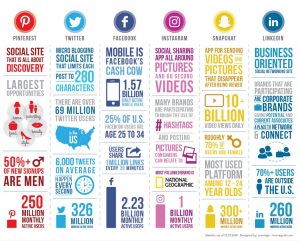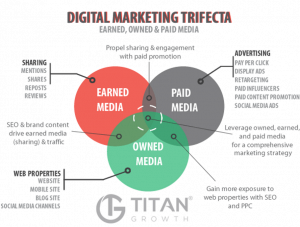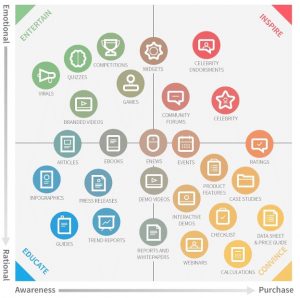Module 3: Readings and Videos Part I

Overview
Unlike traditional methods of marketing, digital marketing gives you the opportunity to speak directly with your target market. This provides a whole new series of platforms to help you build not only brand awareness but also your reputation in the marketplace. Social media is a critical tool for building a reputation and relationship with your audience. This module in the course, you will take a journey into the fascinating and dynamic realm of social networking and social media.
Module Objectives
Upon completion of this part of the module you should be able to:
- Develop a social media campaign plan and design an effective campaign.
- Select the best social media platform(s) for strategic social media efforts.
- Assess the measures needed to evaluate the results of a social media campaign.
- Describe and analyze best practices for performing social media marketing on Facebook, Twitter, Pinterest, YouTube, LinkedIn, Instagram, and Snapchat.
What is Social Media?
Please watch this overview video:
The video was created by Eric Qualmann, who wrote a book called Socialnomics, describing how the advent of social media and the growth of the Internet has changed how people live, shop, and buy. Social media has become a staple in successful marketing campaigns because of how it enables you to connect with your market, nurture relationships, and build your reputation.
Social Networking is a method of creating a network of relationships through a social media platform. Different social media platforms reach different audiences in different ways.
Social media is:
- Engaging customers: It’s talking to your customers, learning what challenges they face and why they are seeking you out. It’s talking with them, not just at them, to improve their user experience.
- Building know, like, and trust: Whether we’re purchasing a product or hiring a plumber, we make purchasing decisions based on who (or what) we know, like and trust. When you’re hiring an attorney, for example, the first thing you’d do is see if there’s an attorney that your friends or family recommends, right? Know, like, and trust.
- Building brand awareness: Whether you’re a large business or a small business, it is important to build awareness of your company and brand. No matter how great your product or service, if no one knows you exist, your business will fail. So, what are you known for to your target market? Social media is an effective tool for not only spreading awareness of your company but also as an expert in industry.
- Networking: Just like that Chamber of Commerce happy hour you attended last week, social media is a method of networking. You’re just changing the physical location to your office or living room. Social media provide an opportunity to create connections, build valuable teaming relationships, and foster relationships.
- Providing customer service: How many of you have had an example of bad customer service (Comcast, anyone?)? Social media provides a public environment for you to provide outstanding customer service for all of your target market to see. And because it’s so public, how you respond to negative reviews or complaints on Twitter become critical. How you respond to negative is just as (or more) important as the positive service you provide.
That being said, with social media, like all marketing, you get what you give. If you create a social media account, and either don’t post or post very rarely, you will not reap the benefit (and leads!) that you could be if you were using it consistently and persistently.
The very first step in getting the most out of your social media is understanding your target market. As we discussed in week 1, your marketing should be driven by providing value to your audience. What needs and wants drive your target market to seek out your product or service? Your market’s habits and practices are also important. It makes no sense to create a Facebook page if your target market is primarily using Instagram.
The next important step is understanding the different social media platforms. Know who uses those platforms and how to communicate on it. Understand the positive and negative aspects of each platform, and have a plan for how to use them.
The following infographic illustrates some key facts about each of the top six platforms. Your homework assignment this week will be to choose two social media platforms for your company. This infographic should help you get started in the right direction.

Many businesses approach social media with one goal in mind: to go viral. While there is no definite way to predict the virality of any given content, one important element is emotion. People make decisions emotionally and justify their decisions logically. Because of this, you will see much more engagement and activity if there is an emotional response. It’s why you see so many social media posts shared that center around animal rescue or child abuse. They evoke emotions that make people want to share.
Social Media Planning
Social media, just like any marketing methods and tactics, requires planning and strategy. Before you jump head-first into new social media platforms or a new social media campaign, you need to make several critical decisions, including:
- What are your goals?
- What value can you provide?
- Can you be consistent and persistent?
Social media goals may be as vague as “build awareness” or as specific as “drive $10,000 traffic to website in the month of September.” Some possible social media outcomes include building relationships, customer engagement, brand-building, lead generation, and promotion. In your social media plan, you will need to determine your objectives, choose appropriate social media platforms, strategize your content, distribute and promote your content, and measure the success of your campaign.
Objectives
Along with the big-picture marketing goals, you will also want to develop social media-specific objectives in your plan. Some possible objectives might look like this:
- Find new customers through social media posts
- Find new customers through social media ads
- Find new customers through search engines (by way of social media)
- Increase customer loyalty through social media posts
- Increase customer loyalty through social media ads
- Increase customer loyalty through social monitoring
- Gain customer insights through social listening
Choosing Social Media Platforms
While many large corporations are present on all social media platforms, some multiple times (Nike has more than 300 social media accounts!), not all companies should be on every platform. Because each platform reaches a different audience with different content requirements, it makes sense to analyze each platform in relation to your target market, marketing goals, and content capabilities to select the platform(s) that makes the most sense.
Some factors to take into consideration when choosing a platform include:
- Who is your audience?
- Where is your audience?
- What content will you use?
- What is your budget?
- What is the tone of your marketing?
- What are your marketing goals?
Earned, Owned, and Paid Media
Part of building your online reputation is increasing your earned media. As demonstrated in the following image, people are much more likely to trust reviews than advertisement. Likewise, people are more likely to trust what someone else says about your company over what you say yourself.
As demonstrated in the image below, earned media is one of multiple elements in a content strategy. Earned media is the result of user engagement. Other types of media include paid media and owned media. Examples of each are provided below.

Because people are more likely to trust something someone else says about you than they are about what you say yourself, earned media can be quite powerful. Earned media is publicity and media recognition that you receive from outside sources (think magazines, blogs, websites, television shows) without you paying for advertising. It’s public relations, which in the new world of marketing, is supported through your use of social media, website, and other online tactics.
As part of your social media planning process, you will want to identify your company’s paid, owned, and earned media and decide whether you have developed a balanced approach to all three.
Going Viral
How many of you know what viral marketing is? I’m sure you’ve all seen a video or meme that someone else shared with you at some point. Viral marketing is when one person watches a piece of content then shares it with their friends. Their friends share with their friends and so on, which increases the visibility exponentially. Pretty soon, you have a Gangnam Style-Type video that just about everyone has seen, it seems.
There is no surefire method to ensure that a given piece of content will go viral, and there are no guarantees, but you are definitely more likely to go viral if you can create an emotional impact of some sort. Consider these successful and unsuccessful viral campaigns. Both campaigns went viral. Why is one considered successful and not the other? What could Ragu have done differently to prevent these results? What did ASL do right?
A company that gets a lot of attention on Twitter because of its snarky content and attitude is Wendy’s. Wendy’s has also engaged in successful viral awareness (Start at 2:25 in the video), though they did not have to build any of the content themselves. How did this situation go viral without the benefit of content or video? What made it successful or not?
The formula to measure virality of content is:
1 person watching the video = X more views
X = pf * N * pv
pf is the probability of forwarding
N is the number who receive or see the forward
pv is the probability of viewing the forward
On a fun note: Watch this video about Mr. Splashy Pants to see how one non-profit organization lost control of a campaign…and had wild success.
Content Marketing
A major part of marketing online is developing original content for your business to share. This has been one of the most valuable tools a business can use to entice customers and clients to them for the past several years. Today’s consumers have less time than they used to and significantly more choices. It is, therefore, key that a business is very clear on exactly why their client (regardless of whether they are B2C or B2B) should choose their company over the competition.
While creating content is important, it is equally important to plan ahead and develop a strategy for creating, delivering, and maintaining your digital content. Your content strategy should provide visitors with:
- Self-discovery – the ability to easily explore your website to find your content and answer their questions.
- Tailored message – The language and approach that your visitors are most likely to relate to.
In his video, “The Beginner’s Guide to Content Marketing in 2020,” Neil Patel presents tips and information for beginners about creating effective content in 2020.
Original content allows a business to demonstrate, not just tell, that it is an expert in the industry. The following video lists several options for content marketing. Regardless of who the audience is, a business needs to create quality content that demonstrates why they stand out and provide value.
Content marketing provides a business with so many benefits, yet so few companies do it well. Content marketing published on your website or social media platforms provides your audience with value to encourage them to keep returning to you for more. It enables you to demonstrate your expertise and knowledge rather than just telling them you’re an expert. Good, interesting content marketing can drive traffic to both your website and social media platforms.
The word “content” is vague and covers a wide variety of options. So how do you know what kind of content to create? The following matrix, created by Smart-Insights, gives some great ideas for how to use which types of content for different marketing goals.

In addition to your extra reading this week, here are some videos to help you come up with ideas for content that your project company might use for effective inbound marketing:
- Digital Marketer, “The Ultimate List of Blog Post Ideas“
- Moz, “The 10 Types of Content That Work Best for SEO – Whiteboard Friday“

